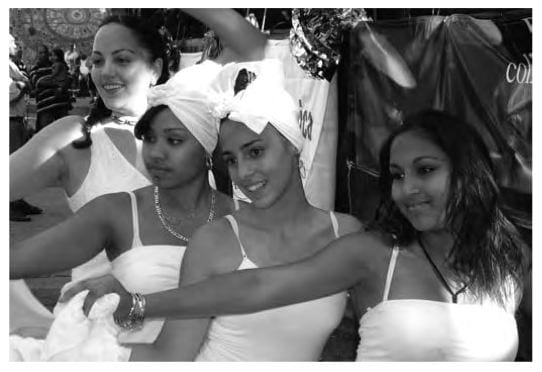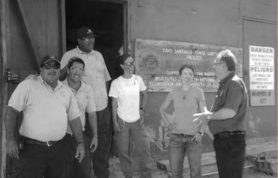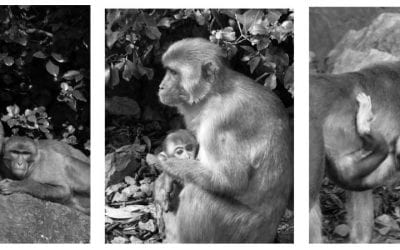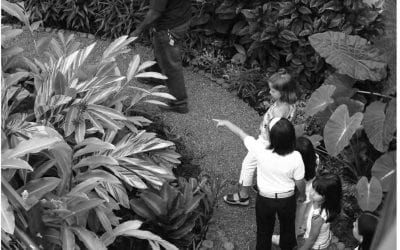The Creation of the Villa Victoria
Today’s Legacy

Villa victoria celebrates Puerto rican traditions through music and dance. Photo courtesy of Inquilinos Boricuas En Accion (IBA)
I can’t help thinking of New Year’s Eve at the Boston housing development Villa Victoria. Even as I stroll through the streets of Boston’s South End in the emerging spring, I reminisce how the scene came to life at midnight on New Year’s Eve. People of all ages poured into the streets to the festive music of parrandas and shouts of, “Feliz año!” Men, women and children treat each other almost as extended family, in a way that no longer exists in our closed-door modern cities. This is because the Villa Victoria has a story and legacy as exceptional as its name, important for not only the children of the Villa (as residents affectionately call it), but for all of us.
The windows and small yards of the townhouses sparkled with lights, creating a whimsical winter wonderland. Images of Puerto Rican culture alongside tasteful Martha Stewart-like decorations and an occasional blow-up snowman reflect the residents’ pride in their homes and neighborhood. In fact, a pedestrian coming upon the Villa Victoria from the posh, brownstone-lined streets of the South End would probably not realize that she had entered a housing development. The brick townhouses painted in soft yellows, peaches, greens, and browns, and highlighted by Spanish ironwork, do not fit a stereotypical picture of the “projects.”
The story of the Villa I share is one that I first learned working there on social justice issues for more than 12 years. It is an oral history that I have since heard repeated many times by my friends and now relatives, as my husband’s family was one of the first to move into the Villa.
In the early 20th century, abandoned by Boston’s elite, the South End became an affordable neighborhood for immigrant and poor communities, among them Syrians, Greeks, African Americans, Chinese and Puerto Ricans (Mario Luis Small,Villa Victoria: The Transformation of Social Capital in a Boston Barrio, 2004). The Puerto Ricans settled primarily in the area between Tremont and Washington Streets known as Parcel 19. While apartments were affordable, the condition of the housing was deplorable and the neighborhood soon became targeted in the 1950s as part of Boston’s urban renewal project.
The urban renewal project started in the West End, which was “renewed” by being demolished. The West End redevelopment controversy and the displacement of its families reverberated throughout Boston but most especially in a South End fearful of sharing the West End’s fate.
As the city’s focus turned to the South End’s Boricua (“Boricua” is another word for Puerto Rican) enclave for renewal, a group of mostly Puerto Rican residents met in the basement of St. Stephen’s Church in the late 1960’s to fight for their community. The group which incorporated as the Emergency Tenants’ Council (ETC) and later formed the sister social service organization, Inquilinos Boricuas en Acción (IBA), rallied the neighborhood with the motto “no nos mudaremos de la parcela 19″—“We’re not going to move from Parcel 19.”
Residents admitted that living conditions needed to be improved. However, they did not want the community to be displaced, and they wanted their voices clearly heard in any renewal plan. Through a widespread and active organizing campaign strengthened by allies—priests and nuns, neighbors outside the parcel, redevelopment professionals, and college volunteers—ETC won the unprecedented right from the city in 1969 to serve as the developer for Parcel 19. ETC flew one of its allies, an architect named John Sharratt, to Puerto Rico to study the architecture that would feel most like a community to them. The architecture of the resulting Villa Victoria achieved that goal, with its plaza and parks and casitas facing one another. The development also provided a facility for the elderly to keep aging relatives close. Several indoor community spaces included a youth and arts center, a community credit union, and the home of one of the first bilingual preschools in the country.
When the Villa was completed in 1976, residents, fueled by the pride that came from preserving their neighborhood, turned to strengthening human service programming. In the early 80s, a partnership between an active parent in the neighborhood, Ada Palmarin, and a Harvard student, Remy Cruz, led to the formation of the Keylatch Program of the Phillips Brooks House Association, offering free tutoring, big brother/ big sister and summer programs for neighborhood children. Jorge Palmarin, Ada’s son and an original participant in the program reflects, “Not only did Keylatch give us a place to go and be safe, but it also gave us a learning structure and a way to build friendships across the neighborhood.” I have been fortunate to inherit the trusteeship of this program and observe 10 years of students who in serving others and continuing that community-building tradition have become deeply moved by the story and legacy of the Villa.
It is through Keylatch and personal relationships that I have also seen this legacy fading and known the very real obstacles many of the children and grandchildren of those first residents face. While the original residents fought for and won the Villa, its walls could not keep out the challenges afflicting our poor communities, from insufficient educational opportunties to addiction to violence. The original story has at times been overshadowed by heart-breaking stories of loss community members have experienced. And as new residents move in and children move away, fewer current residents know the story of the Villa’s beginnings first-hand if at all.
Even so, there is palpable power in the legacy of those who fought to create the Villa. It is in the energy of Villa Victoria on a hot summer day or the shimmer of those holiday lights; it is at the annual Festival Betances in July to commemorate ETC’s victory; it is at the community’s Jorge Hernández Cultural Center; and it is there every day when I pick up my two-year-old son from his grandmother’s house. I know that I am leaving him in loving hands, but more than that, in any given day two to three people who know him will stop and say “que dios le bendiga.” It is a rare gift for a child in Boston to be so blessed by his community. Such gifts must live on and a new generation must take responsibility for the story. In the words of my once colleague and now sister-in-law Jenny Gray, which I first heard 12 years ago when she introduced me to the Villa, “It is so important that they [the children and youth of the Villa] know their history and the story of how people fought for this community. It is how they know what they are capable of and believe in themselves, how they know to fight for what is just, and how they care about one another and their community.” Pass it on.
Spring 2008, Volume VII, Number 3
Maria Dominguez Gray is the Deputy Director of the Phillips Brooks House Association and holds a M.Ed. from the Harvard Graduate School of Education. She would like to dedicate this article to her growing family and to all those children and grandchildren of the original Villa generation who fight to keep the legacy alive.
Related Articles
A Look at Cayo Santiago
It doesn’t look like a zoo. Indeed, on Cayo Santiago, a 38-acre tropical island off Puerto Rico’s coast, the only mammals in cages are human beings. Edmundo Kraiselburd, the affable director…
Monkeys and Men
What does who opens the door on a date on a frigid Cambridge evening have to do with a lush island off the shores of Puerto Rico? For that matter, what does this island, teaming with…
A Green Classroom
“Aula Verde” is the name of an ecological park and science center for school children in Puerto Rico. It was an appropriate visit for the third Puerto Rico Winter Institute, dedicated to water and…




